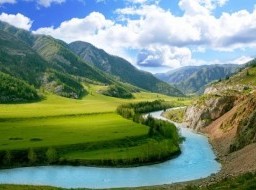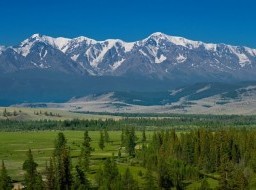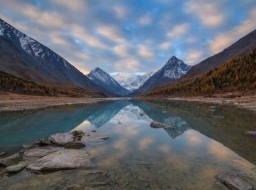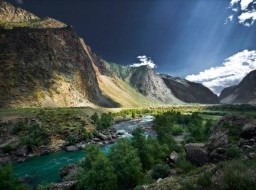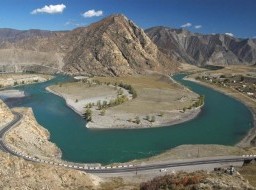Altai
Altai is one of Siberia’s most valuable areas of historical and cultural heritage: over 5,000 monuments of archeology, architecture, history and culture are there. Altai Republic contains the “Golden Mountains of Altai” UNESCO World Heritage Site, three federal protected areas, 120+ natural monuments, and a growing number of regional nature parks and reserves. Remote and wild river valleys, wind-blown steppe, and snow-capped peaks – habitat for snow leopards, argali sheep, and other species – are a rare remnant of intact mountain wilderness. Altai Krai is located in the southeast of Western Siberia. The region lodges 12 cities. The territory’s population surpasses 2.5 million people, representatives of more than 80 nationalities and ethnic groups inhabit Altai, with Russian people prevailing. The territory presents quite a variety of landscapes — flat grassland steppes, wooded steppe and forests, and mountains. Thousands of beautiful pure?water lakes and rivers are located in the Altai Krai. The lands of Altai embody a natural object of global value — the site where the Ob river, one of the largest on the planet, is formed. There are hollows with semi-desert landscapes, Alpine peaks, narrow river canyons and broad valleys, highland tundra landscapes and deep natural staffs in the thickness of limestone, cereal steppes and eternal snow and glaciers, stony placers and tracts of forest. Natural zones of the Republic build up a many-storeyed world of mountain landscape. Forests cover more than a half of the mountain territory. One third of the territory of the Altai Republic is occupied by highlands. In the mountains of South-Eastern Altai, there are such altitude and zonal landscape types, as tundro-steppes, not found in other climatic zones. Altai is a blissful place for archeological research and discovery. The earliest evidence of prehistoric human habitat in Northern Asia was found in Denisov Cave and its vicinities. The unique finds recently made by archeologists, indicate that the Altay land has not yet disclosed all its well?kept secrets. Every year the numbers of tourist centers, camping sites, hotels in Altai Krai increases, new itineraries are worked out, mountain skiing slopes are opened, one can enjoy rafting on mountain rivers, horse?back riding, flights on paragliders, etc. The Altai keeps rich traditions of treatment in its sanatoria and health resorts. Local indigenous peoples have managed to retain much of their age-old culture and traditional lifeways, with many still practicing semi-nomadic livestock agriculture and subsistence hunting and fishing. Altai, as one of the few places in the world in which a unique type of oral folklore endures, is a place of storytelling. Storytellers, known in Altai as kaichi, perform their work through throat singing, with accompanying music on the tapshure, a two-stringed musical instrument. Kaichi sing both folk songs and heroic epics - known as kai. Do not miss the chance to listen to kaichi, as they are very impressive. The longest kaichi performance can last several days. In the mountains most popular are active itineraries. Rafting on the downstream Katun allows one to receive a high dose of adrenaline, when rafting or canoeing on catamarans along the simplest routes up to extreme ones. The Katun River is one of the most famous and relatively accessible attractions of the Altai Republic. Many legends about the Katun exist among the local people - almost all of them include the daughter of Khan Altai, who seeks her beloved Biya (Biya is yet another Altai river) - and so as the Katun River turns, along with the Biya River it merges into the Ob, Siberia’s largest waterway. Speleology tours in Altai Krai have unlimited opportunities. There are a lot of caves easy to roam for anyone. The underground world of Altai is not yet completely studied, and here one can make surprising discoveries. The days‑long walking and horse‑back tours are getting increased popularity in a number of areas. By now, coming to Altai, tourists can have a comfortable accommodation for their rest, see a number of archeological sites, and get acquainted with history and culture of Scythians. |

